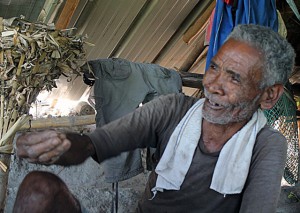The local government unit of Bamban, Tarlac plans to adopt the national program dubbed as Upland Rice Development Program (URDP).

The program will prioritize the indigenous peoples, particularly, the Aetas to help them become rice sufficient and food secured, according to the agricultural extension worker assigned in Bamban.
Roderick Castro, an agricultural extension worker in Bamban for 17 years, said that their local chief executive, Jose Antonio Feliciano wanted to continuously tap the upland areas to help them attain rice self-sufficiency as most of their rice areas are found in the uplands.
Meanwhile, Nardo Baclay, an Aeta farmer, who is in his 70s, participated with no regrets in the Upland Palayamanan Farmer Field School of URDP.
Nardo has been into farming for more than 40 years. He tills a land on top of the mountain, which is a one-hour walk from the foot of the mountain.
Prior to URDP, he only planted taro, banana, papaya, and root crops. He usually left the mountain at dawn to sell his produce in the market. He spent his income in buying rice. He seldom planted rice owing to the inaccessibility or unavailability of seeds in their area.
With URDP, Baclay met new people who taught them new things such as mushroom cultivation. He hopes that all his fellow farmers will cultivate mushroom as this will provide them additional income in order to buy more rice for their families.
He was also excited about the aromatic traditional rice variety known as Pinilisa, which was introduced to him by Julian Macadamia, the upland technologist assigned in Tarlac. In May which is the onset of rainy season, he started planting Pinilisa and harvested it in October.
The good performance of Pinilisa in his area made him decide to seed produce them next year rather than consuming them. He thought that more seeds produced mean more farmers will be benefiting from those seeds.
His fellow farmers also take time to visit his area even it is far. One of them said, “Your crops grow well. Please produce more and give us some seeds later.”
To grow upland rice is not a futile attempt for Baclay. He is not even threatened by the presence of rats, chickens and weeds in his field as well as the unavailability of irrigation.
He manages them well. He let his cats manage the rats. He does hand weeding every time he sees even a few of them. He stays in the field at the onset of rice’s flowering until the rice is ready to harvest toward the chickens off. He does not run out of ways on how to bring water from the creek to his field.
“It makes your work even harder if you are still thinking where to get your food for the day,” Baclay said.




